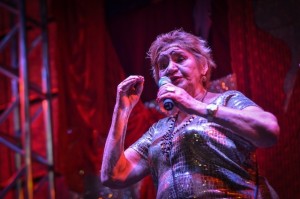In late November, 2015, the Institute of Philosophy and Social Sciences of the Federal University of Rio de Janeiro (IFCS/UFRJ) hosted a one week course called “A particular revolution: the Brazilian prostitute movement“. The course examined the roots, history, contexts and connections of the prostitutes’ movement since its founding in the 1970s. The Prostitution Policy Watch, an extension project of the UFRJ, organized the course and gathered together sex workers, researchers and activists engaged with the subject to discuss the movement’s role in the construction of Brazil’s democracy and to debate sexual and labor rights. SPW interviewed Laura Murray, a recognized researcher on sex work and one of the course organizers. She emphasized that the course was aimed at creating space for the academy to more fully engage in debates about prostitution, both in terms of its labor aspects and with regard to its political and social dimensions.
Tell us about the course.
The course was originally conceptualized by the Prostitution Policy Watch with Gabriela Leite several years ago. The goal was to open up an academic space, without the stigma that usually surrounds the subject, in which the Brazilian prostitutes’ movement could share its history with students and the broader public.
One of the course’s objectives was to show something that sex worker activists frequently affirm: that they are also professors, and that we can often learn more from the knowledge gained on the streets, corners and activism than what is taught in the classroom. A central idea of the course was to have sex worker activists as professors in an university setting as a way to talk about the prominent role they’ve played in the recent political and social history of Brazil in fights for labor rights, professional recognition and HIV/ AIDS prevention.
What is the most outstanding feature of the Brazilian sex workers movement’s trajectory?
Broadly speaking, its contribution to democratization and, in particular, how it contributed to radically changing dominant discourses about prostitution in Brazilian society. Having emerged in the 1970s, the movement fully participated in re-building of democracy. Neither prostitution nor Brazil have been the same since the movement began. In the course of their activism, organized prostitutes have changed, advanced I would say, meanings of key concepts such as citizenship, democracy, activism, sexuality and gender. They’ve also transformed the use and understanding of colloquial terms such as street walking and puta [whore].
What role did the personal stories of prostitutes play in constructing the movement?
Their political demands and struggles emerge from their professional and personal lives, from their personal dramas and challenges. Without these elements the movement would not exist. The lives of Lourdes Barreto and Gabriela Leite — who was the founder of the movement – beautifully illustrate these connections. The course was a tribute to Gabriela. Her personal path and political philosophy continues to guide the actions implemented by the Policy Watch and, I would say, is extremely present in the ways in which sex work research and activism is conducted today in Brazil. It is impossible to talk about prostitution and not mention Gabriela.
Lourdes continues to be very active in the movement. She even tattooed “I’m a puta” on her arm few weeks before the course! She has a contagious strength and is politically brilliant. She delivered a fabulous and exciting speech opening night in which she recaptured the history of the movement, remembering how hard it was, in the early days, to even talk about prostitution. She made quite clear what a huge achievement it is to be able to openly talk about prostitution in a public university. She also highlighted the key role played by the progressive Catholic Church at the beginning of the movement. She told a wonderful story about how she and Gabriela met at an event organized by the Catholic Pastoral for Marginalized Women, in the mid-1980s. When they realized that those organizing the event were, in fact, deploying an anti-prostitution ideology and intended to rescue them from the profession, they openly contested these views and a major debate ensued – as Lourdes said, the event, “caught on fire”. It was then that Lourdes and Gabriela decided that time was ripe to found their own movement.
Lourdes shared a wealth of details about this first encounter and spoke about the harsh difficulties of those times – for example, how hard it was to find a hotel that would accept sex workers as hotel guests. In short, her memory allowed the audience to feel close to their experiences in those early years.
The stories told by Lourdes as well as by other prostitute leaders participating in the course — Betania Santos, Cida Viera, Indianara Siqueira, Nilce Machado and Amara Moira – reflected the experiences of women from the most diverse corners of Brazil. Because they are sex workers, they are usually portrayed from the point of view of stigmatized sexuality and dominant morality and also connected to the broader politics of neglect and informality that characterize how many public interest issues are treated in Brazil. To speak about the Brazilian prostitutes’ movement is, therefore, to also talk about the political and poetic production of knowledge about Brazilian sexuality and morality, and through these lenses, also examine the peculiar ways in which distinctions between public and private are both drawn and blurred in the current political practices and discourses.
 Tell us about the composition of the Brazilian prostitutes’ movement and how this appeared during the course?
Tell us about the composition of the Brazilian prostitutes’ movement and how this appeared during the course?
The movement is very diverse and has many partners. The course sought to highlight this heterogeneity. There were researchers who spoke about the history of prostitution in Rio de Janeiro, such as Juçara Leite, Aparecida Moraes and Beatriz Kushnir. Paulo Knauss, the current director of the National Historical Museum, who was the director the Public Archive of State of Rio de Janeiro (APERJ) when the ONG founded by Gabriela (Davida) donated its archive with over thirty years of history of the movement was also present. The Prostitution Policy Watch continues to have an important partnership with the APERJ. Professor and pastor Zwinglio Dias also participated. He had a key role in the early days of the movement when he mobilized the financial support with the World Council of Churches for the first national meeting of prostitutes in 1987.
We also had few key partners who are state actors, such as Congressman Jean Wyllys’ office and Adriana Motta who in November was at the Rio de Janeiro state office on women’s rights. Another important presence was Soraya Simões, the coordinator of the Prostitution Policy Watch and president of Davida’s board. The student fellows of the Watch were amazing in their work plan and realize course and several even tore up the Daspu catwalk during the fashion show.
In summary, there are many bridges with a wide range of actors who are part of the movement. People who are  described by Flávio Lenz and Friederike Strack as “affective allies” [aliados afetivos]. In fact one of the panels of the course had exactly this title and was devoted to discuss the role of this group of people who – though not sex workers – are also an important part of the movement’s history. This was not a course where experts spoke about prostitution, but rather a space with people from very diverse fields who are part of the movement and advocate for its interests, needs, and demands.
described by Flávio Lenz and Friederike Strack as “affective allies” [aliados afetivos]. In fact one of the panels of the course had exactly this title and was devoted to discuss the role of this group of people who – though not sex workers – are also an important part of the movement’s history. This was not a course where experts spoke about prostitution, but rather a space with people from very diverse fields who are part of the movement and advocate for its interests, needs, and demands.
What are the main challenges currently faced by the prostitutes’ movement?
I think that, given the current climate in which conservative forces have gained so much force, sharing the movement’s experiences and memories is vital to advancing the struggle for sex workers’ rights. There is not much room or space for these issues to be systematically discussed, and this lack of space is a challenge in and of itself. It is extremely important to discuss the world of prostitution and the movement’s contribution as a constituent element of the history of many places, cities and the country itself.
This is why the movement’s cultural interventions are so important – they ensure the visibility of sex workers’ political demands. This is what happens with the Daspu catwalks and Puta Dei celebrations (June 2), which began in Belém do Pará and have rapidly spread across the country. Or in the Miss Prostitute contest, organized by Aprosmig in Belo Horizonte.
Having said that, the lack of a more systematic, broad and open political debate on the challenges faced by movement was felt during the course. People who participated were really anxious and excited to learn and interact with the world of prostitution and the history of the movement.
And how was the DASPU fashion show that took place at the end of the course?
It was really fantastic! It was a striking and beautiful moment where everyone’s enthusiasm was palpable. I will never forget how amazing it was see the red lights illuminating the façade of Institute of Philosophy and Social Sciences. The staircase of the Institute became a brothel with Lourdes Barreto playing the role of the ‘madam’. The performance included female, male and trans sex workers, students, hustlers, and activists. Students and professors leaving the building also interacted with the show. It was really an amazing way to illustrate the diversity of subjects who are involved in prostitution and who engage with the movement. It also made the relationship between prostitution and urban settings visible and drew attention to the relevance of public spaces for political visibility and activism. But for me, the best part was something that was entirely unexpected and unprecedented. At the end of the performance, a technical problem with the sound system meant that the Daspu funk music couldn’t be played. When this happened, sex worker leaders took the microphone and gave an amazing show! They spoke about the movement, their rights and citizenship. It was another master class thought by the best professors of all.
